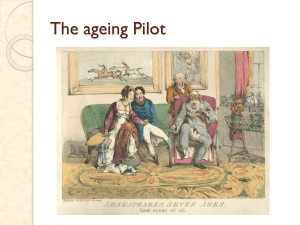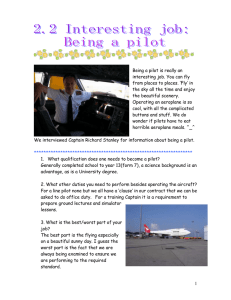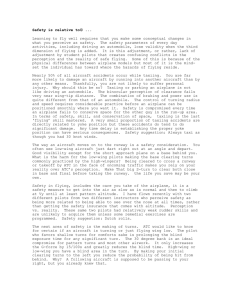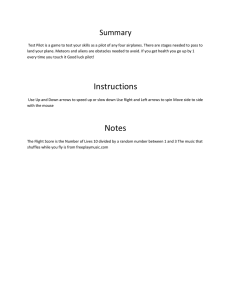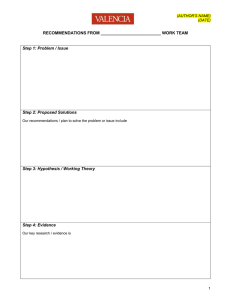Cockpit Interruptions and Distractions: Effective Management Requires A Careful Balancing Act .
advertisement
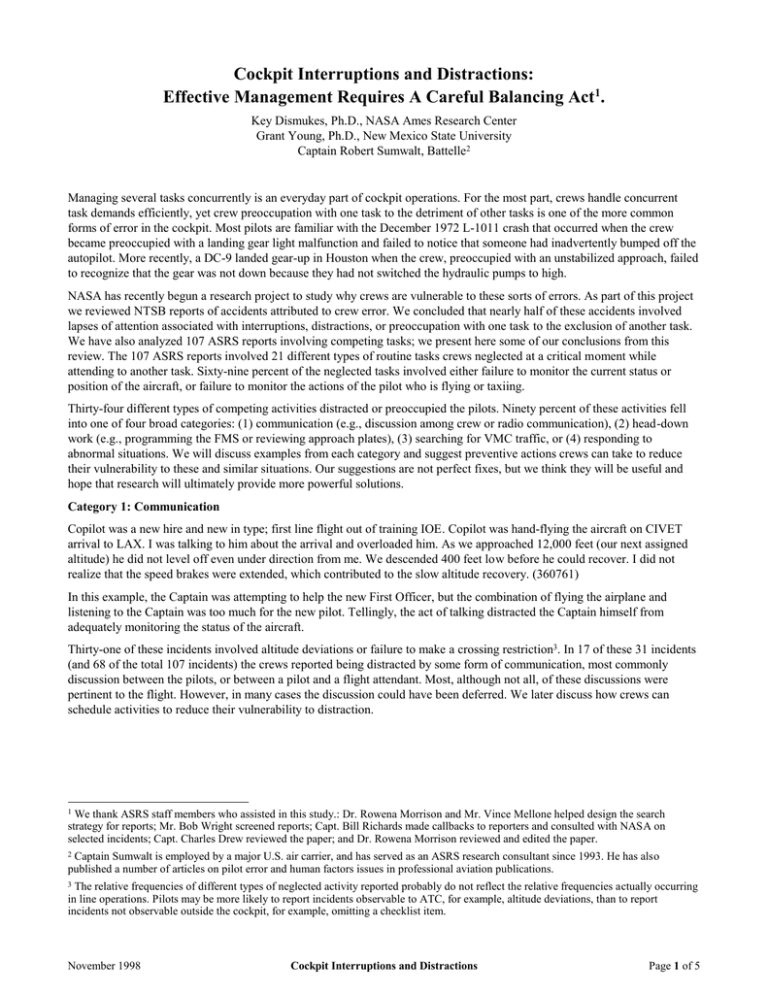
Cockpit Interruptions and Distractions: Effective Management Requires A Careful Balancing Act1. Key Dismukes, Ph.D., NASA Ames Research Center Grant Young, Ph.D., New Mexico State University Captain Robert Sumwalt, Battelle2 Managing several tasks concurrently is an everyday part of cockpit operations. For the most part, crews handle concurrent task demands efficiently, yet crew preoccupation with one task to the detriment of other tasks is one of the more common forms of error in the cockpit. Most pilots are familiar with the December 1972 L-1011 crash that occurred when the crew became preoccupied with a landing gear light malfunction and failed to notice that someone had inadvertently bumped off the autopilot. More recently, a DC-9 landed gear-up in Houston when the crew, preoccupied with an unstabilized approach, failed to recognize that the gear was not down because they had not switched the hydraulic pumps to high. NASA has recently begun a research project to study why crews are vulnerable to these sorts of errors. As part of this project we reviewed NTSB reports of accidents attributed to crew error. We concluded that nearly half of these accidents involved lapses of attention associated with interruptions, distractions, or preoccupation with one task to the exclusion of another task. We have also analyzed 107 ASRS reports involving competing tasks; we present here some of our conclusions from this review. The 107 ASRS reports involved 21 different types of routine tasks crews neglected at a critical moment while attending to another task. Sixty-nine percent of the neglected tasks involved either failure to monitor the current status or position of the aircraft, or failure to monitor the actions of the pilot who is flying or taxiing. Thirty-four different types of competing activities distracted or preoccupied the pilots. Ninety percent of these activities fell into one of four broad categories: (1) communication (e.g., discussion among crew or radio communication), (2) head-down work (e.g., programming the FMS or reviewing approach plates), (3) searching for VMC traffic, or (4) responding to abnormal situations. We will discuss examples from each category and suggest preventive actions crews can take to reduce their vulnerability to these and similar situations. Our suggestions are not perfect fixes, but we think they will be useful and hope that research will ultimately provide more powerful solutions. Category 1: Communication Copilot was a new hire and new in type; first line flight out of training IOE. Copilot was hand-flying the aircraft on CIVET arrival to LAX. I was talking to him about the arrival and overloaded him. As we approached 12,000 feet (our next assigned altitude) he did not level off even under direction from me. We descended 400 feet low before he could recover. I did not realize that the speed brakes were extended, which contributed to the slow altitude recovery. (360761) In this example, the Captain was attempting to help the new First Officer, but the combination of flying the airplane and listening to the Captain was too much for the new pilot. Tellingly, the act of talking distracted the Captain himself from adequately monitoring the status of the aircraft. Thirty-one of these incidents involved altitude deviations or failure to make a crossing restriction3. In 17 of these 31 incidents (and 68 of the total 107 incidents) the crews reported being distracted by some form of communication, most commonly discussion between the pilots, or between a pilot and a flight attendant. Most, although not all, of these discussions were pertinent to the flight. However, in many cases the discussion could have been deferred. We later discuss how crews can schedule activities to reduce their vulnerability to distraction. We thank ASRS staff members who assisted in this study.: Dr. Rowena Morrison and Mr. Vince Mellone helped design the search strategy for reports; Mr. Bob Wright screened reports; Capt. Bill Richards made callbacks to reporters and consulted with NASA on selected incidents; Capt. Charles Drew reviewed the paper; and Dr. Rowena Morrison reviewed and edited the paper. 1 Captain Sumwalt is employed by a major U.S. air carrier, and has served as an ASRS research consultant since 1993. He has also published a number of articles on pilot error and human factors issues in professional aviation publications. 2 The relative frequencies of different types of neglected activity reported probably do not reflect the relative frequencies actually occurring in line operations. Pilots may be more likely to report incidents observable to ATC, for example, altitude deviations, than to report incidents not observable outside the cockpit, for example, omitting a checklist item. 3 November 1998 Cockpit Interruptions and Distractions Page 1 of 5 Research studies have shown that crews who communicate well tend to perform better overall than those who do not. But conversation has a potential downside because it demands a substantial amount of attention to interpret what the other person is saying, to generate appropriate responses, to hold those responses in memory until it is one’s own time to speak, and then to utter those responses. One might assume that it is easy to suspend conversation whenever other tasks must be performed. However, the danger is that the crew may become preoccupied with the conversation and may not notice cues that should alert them to perform other tasks. (The accompanying sidebar explores the nature of interference between competing tasks.) Special care is required to avoid distraction when others enter the cockpit, because they may not recognize when the pilots are silently involved in monitoring, visual search, or problem-solving Category 2: Head-Down Work “…Snowing at YYZ. Taxiing to runway 6R for departure. Instructions were taxi to taxiway B, to taxiway D, to runway 6R.…as First Officer I was busy with checklists [and] new takeoff data. When I looked up, we were not on taxiway D but taxiway W.…ATC said stop….” (397607) In a review of airline accidents attributed primarily to crew error over a 12-year period4, the NTSB concluded that failure to monitor and/or challenge the Pilot Flying contributed to 31 of the 37 accidents. In 35 of the ASRS incidents we studied, the Pilot Not Flying reported that preoccupation with other duties prevented monitoring the other pilot closely enough to catch in time an error being made in flying or taxiing. In 13 of these 35 incidents (and 22 of the total 107 incidents), the Pilot Not Flying was preoccupied with some form of head-down work, most commonly paperwork or programming the FMS. Monitoring the Pilot who is flying or taxiing is a particularly challenging responsibility for several reasons. Much of the time the monitoring pilot has other tasks to perform. Monitoring the other pilot is much more complex than monitoring altitude capture because the other pilot is performing a range of activities that vary in content and time course. Thus, it is sometimes difficult for the monitoring pilot to integrate other activities with monitoring because he or she cannot entirely anticipate the actions of the other pilot. Furthermore, serious errors by the pilot who is flying or taxiing do not happen frequently, so it is very tempting for the pilot who is not flying to let monitoring wane in periods of high workload. Periods of head-down activity, such as programming the FMS, are especially vulnerable because the monitoring pilot’s eyes are diverted from other tasks. Also, activities such as programming, doing paperwork, or reviewing approach plates, demand such high levels of attention that attempting to perform these tasks simultaneously with other tasks substantially increases the risk of error in one task or the other (see sidebar). Some FMC entries involving one or two keystrokes can be performed quickly and may be interleaved with other cockpit tasks. However, attempting to perform longer programming tasks, such as adding waypoints or inserting approaches during busy segments of flight, can be problematic. It is not possible for the Pilot Not Flying to reliably monitor the Pilot Flying or the aircraft status during longer programming tasks, and it is difficult to suspend the programming in midstream without losing one’s place. Category 3: Searching for VMC Traffic PRADO 5 Departure. Cleared to climb (and) received TCASII TA (which) upgraded to an RA, monitor vertical speed. While searching for the traffic we went past the NIKKL intersection...for the turn to the TRM transition. We had discussed the departure before takeoff; special procedures, combined with many step climb altitudes in a short/time/distance, made this a more demanding departure than most. Next time on difficult departures I will use autopilot sooner...will try to be more vigilant in dense traffic areas. (403598) In 16 incidents crews failed to turn as directed by ATC or the SID or STAR they were following. The crews reported various activities competing for their attention; in three cases the activity was searching for traffic called out by ATC or TCAS. Altogether, crews reported searching for traffic as a competing activity in 11 of the 107 incidents. Searching for traffic takes the pilot’s eyes away from monitoring aircraft position and status, and also demands substantial mental attention. If the conflict is close the urgency may further narrow the focus of attention,. One of the insidious traps of interruptions is that their effects sometimes linger after the interruption. For example, descending through 4500 feet, a crew might be instructed to report passing through 3000 feet. They might then respond to and quickly resolve a traffic alert, but forget the instruction to report by the time they reach 3000 feet. In this hypothetical example, searching for traffic preempts the reporting instruction from the crew’s conscious awareness. The instruction presumably is still stored in memory in an inactive form, and if reminded, the crew probably will recognize that they were given the instruction. However, lacking such a reminder and being preoccupied with other activities, they do not remember as they pass through 3000 feet. National Transportation Safety Board (1994). A review of flightcrew-involved major accidents of U.S. air carriers, 1978 through 1990. Safety study NTSB/SS-94-01. Washington, D.C.: NTSB. 4 November 1998 Cockpit Interruptions and Distractions Page 2 of 5 Category 4: Responding to Abnormal Situations Large areas of thunderstorms; we had to deviate considerably. Several (equipment malfunctions) in short period...then cabin pressure started climbing slowly in cruise (FL290). Troubleshooting...to no avail. Requested immediate descent. Descending through FL180, both crew members forgot to reset altimeters, putting us 300 feet low at FL130. To prevent this from occurring again during any abnormal, I will: 1) delegate tasks; have one person focus on flying the airplane while the other troubleshoots and state clearly who will do what, 2) strictly adhere to company procedures. (404306) In 13 incidents crews failed to reset their altimeters when passing through the transition altitude (18,000 feet MSL in the United States and Canada). It is especially easy to forget to reset altimeters if this action is not linked in pilots’ minds to other actions. (For this reason some pilots make resetting altimeters part of a cluster of action items they routinely perform together, e.g., making a passenger announcement and turning on the seat belt sign. Some companies make resetting altimeters part of the descent checklist.) In principle, the problem is similar to that of monitoring for altitude level-off, except more vulnerable to error. In air carrier operations the crew is normally aided with altitude level-off by altitude alerting devices and by the formal procedure of making a thousand-foot call, confirmed by both pilots, before reaching the assigned altitude. ---------------------------------------------------------------------------------------------ABNORMALS = DISTRACTIONS ---------------------------------------------------------------------------------------------Two of the crews reporting to ASRS that they forgot to reset their altimeters stated they were preoccupied with an abnormal situation. Altogether, abnormals were a factor in 19 of the 107 incidents. Ironically, it seems that one of the biggest hazards of abnormals is becoming distracted from other cockpit duties. Abnormals easily preempt crews’ attention for several reasons. Recognizing the cockpit warning indicators, identifying the nature of the problem, and choosing the correct procedure require considerable attention. Crews have much less opportunity to practice abnormal procedures than normal procedures, so choosing and running the appropriate checklists requires more effort and greater concentration of mental resources than normal checklists. Also, in situations perceived to be urgent or threatening, the normal human response is to narrow the focus of attention, which unfortunately tends to diminish mental flexibility and reduce ability to analyze and resolve non-routine situations. Strategies for Reducing Vulnerability to Interruptions and Distractions We suggest several lines of defense against the types of crew errors described above. These are not perfect, but in combination they should, in our opinion, reduce crews’ vulnerability to error. (1) Recognize that conversation is a powerful distracter. Unless a conversation is extremely urgent, it should be suspended momentarily as the aircraft approaches an altitude or route transition, such as altitude level-off or a SID turn. In high workload situations, conversation should be kept brief and to the point. Even in low workload situations, crew should suspend discussion frequently to scan the status of the aircraft and their situation. This requires considerable discipline because it goes against the natural flow of conversation, which usually is fluid and continuous. November 1998 Cockpit Interruptions and Distractions Page 3 of 5 (2) Recognize that head-down tasks greatly reduce one’s ability to monitor the other pilot and the status of the aircraft. If possible, reschedule head-down tasks to low workload periods. Announce that you are going head-down. In some situations it may be useful to go to a lower level of automation to avoid having one crew member head-down too long. For example, if ATC requests a speed change when cockpit workload is high, the crew may set the speed in the Mode Control Panel instead of the FMS. An FMS entry might be made later, when workload permits. Also, some airlines have a policy that FMS entries should be commanded by the Pilot Flying and implemented by the Pilot Not Flying. This approach minimizes the amount of attention the Pilot Flying must divert from monitoring the aircraft. (3) Schedule/reschedule activities to minimize conflicts, especially during critical junctions. When approaching or crossing an active runway, both pilots should suspend all activities that are not related to taxiing , such as FMS programming and company radio calls, until the aircraft has either stopped short of the runway or safely crossed it. Crews can reduce their workload during descent by performing some tasks while still at cruise, for example, obtaining ATIS, briefing the anticipated instrument approach, and inserting the approach into the FMS (for aircraft so equipped). Also, it may be useful for companies to review their operating practices for optimal placement of procedural items. For instance, could some items on the Before Takeoff Checklist be moved to the Before Start Checklist, since the latter is performed during a period that usually has lower workload? (4) When two tasks must be performed concurrently, set up a scan and avoid letting attention linger too long on either task. In some situations pilots must perform two tasks concurrently, for example, searching for traffic while flying the airplane. With practice, pilots can develop the habit of not letting their attention linger long on one task but rather switch attention back and forth every few seconds between tasks. This is somewhat analogous to an instrument scan, and like an instrument scan it requires discipline and practice, for our natural tendency is to fixate on one task until it is complete. Be aware that some tasks, such as building an approach in the FMC, do not lend themselves to time-sharing with other tasks without an increased chance of error. (5) Treat interruptions as red flags. Knowing that we are all vulnerable to preoccupation with interruptive tasks can help reduce that vulnerability. Many pilots, when interrupted while running a checklist, place a thumb on the last item performed to remind them that the checklist was suspended; it may be possible to use similar techniques for other interrupted cockpit tasks. One of us has developed a personal technique using the mnemonic “Interruptions Always Distract” for a three-step process: (1) Identify the interruption when it occurs, (2) Ask, “What was I doing before I was interrupted” immediately after the interruption, (3) Decide what action to take to get back on track. Perhaps another mnemonic for this could be Identify-Ask-Decide. (6) Explicitly assign Pilot Flying and Pilot Not Flying responsibilities, especially in abnormal situations. The Pilot Flying should be dedicated to monitoring and controlling the aircraft. The Pilot Flying must firmly fix in mind that he or she must concentrate on the primary responsibility of flying the airplane. This approach does not prevent each pilot from having to perform concurrent tasks at times, but it does insure that someone is flying the airplane and it guards against both pilots getting pulled into trying to solve problems. November 1998 Cockpit Interruptions and Distractions Page 4 of 5 SIDEBAR Why do activities as routine as conversation sometimes interfere with monitoring or controlling the aircraft? Cognitive research indicates that people are able to perform two tasks concurrently only in limited circumstances, even if they are skillful in performing each task separately. Broadly speaking, humans have two cognitive systems with which they perform tasks; one involves conscious control, the other is an automatic system that operates largely outside of conscious control. 5 The conscious system is slow and effortful, and it basically performs one operation at a time, in sequence. Learning a new task typically requires conscious processing, which is why learning to drive a car or fly an airplane at first seems overwhelming: the multiple demands of the task exceed conscious capacity. Automated cognitive processes develop as we acquire skill; these processes are specific to each task, they operate rapidly and fluidly, and they require little effort or attention. Many real-world tasks require a mixture of automatic and conscious processing. A skillful driver in a familiar car on a familiar road can perform largely on automatic, leaving enough conscious capacity to carry on a conversation. However, if the automatic system is allowed to operate without any conscious supervision, it is vulnerable to certain types of error, especially a type of error called habit capture. For example, if we intend to take a different route home from work, we are prone to miss our turn-off and continue our habitual route if we do not consciously supervise our driving. Also, if we encounter a section of road that is difficult to navigate, we find that we cannot continue the conversation without risking errors in the driving, the conversation, or both. This is because the automatic processes are not adequate to handle the unpredictable aspects of the driving task. Conscious control is required in four situations: i) when the task is novel, ii) when the task is perceived to be critical, difficult, or dangerous, iii) when an automatic process must be overridden to prevent habit capture, or iv) to choose among competing activities. The required mixture of automatic and conscious processing varies among tasks, and the mixture may vary with the moment to moment demands of a given task. Conversation, for example, generally requires a substantial amount of conscious processing because it involves novelty; we do not know what the other person is going to say and we have to formulate unique responses appropriate to the discussion. In contrast, an experienced pilot can manually fly a familiar aircraft in a largely automatic fashion. However, certain subtasks embedded in the act of flying manually require conscious attention. For example, leveling off at an assigned altitude requires consciously monitoring the altimeter to read the numbers and to match the current altitude with the assigned altitude the pilot is holding in memory. The framework outlined above allows some general conclusions about the circumstances under which two tasks may be performed concurrently. A task requiring a high degree of conscious processing, FMS programming, for example, cannot be performed concurrently with other tasks without risking error. Two tasks that are largely automated can be performed together reliably if they are regularly practiced in conjunction, for example, flying the aircraft manually and intercepting the localizer. We are less certain how well individuals can combine two tasks, each of which involves a mixture of conscious and automatic processing, for example, searching for traffic while monitoring for altitude capture. We suspect that pilots can learn to integrate two tasks of this sort and achieve reliable performance, but only if they regularly practice the two tasks in conjunction. This, however, is speculation, and requires experimental research for validation. Norman, D. J. and Shallice, T. (1986). Attention to action: willed and automatic control of behavior. In R. J. Deardin, G. E. Schwartz, and D. Shaprio (Eds), Consciousness and Self-Regulation, Advances in Research and Theory (pp 1-18). New York: Plenum. 5 November 1998 Cockpit Interruptions and Distractions Page 5 of 5
